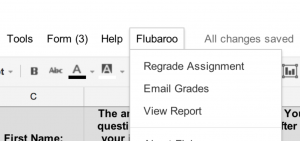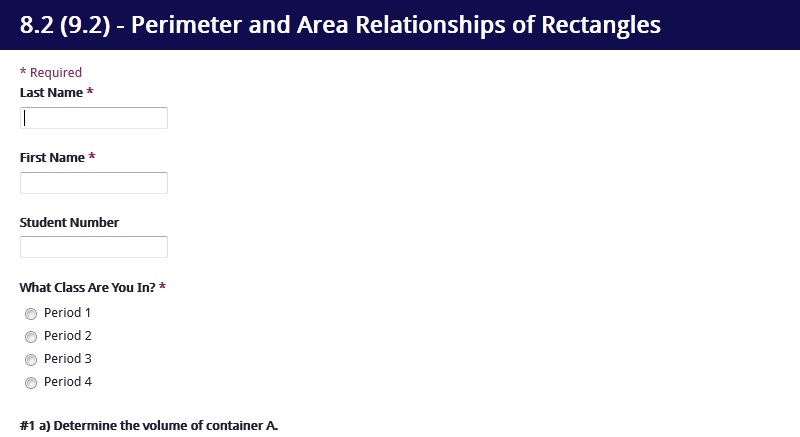Classroom/Audience Response Systems Replaced By Google Docs Forms and iPad
As many already know, students in my math classes use a class set of iPads on a daily basis to complete course work in a paperless format. About three times a week, I will create an online form through Google Docs to allow students to submit answers for formative and summative assessments. A sample worksheet from today’s class and the corresponding online form can be found below:
Sec. 8.2 – Perimeter and Area Relationships of Rectangles – Worksheet
Google Docs Form to Submit Mind Buster Answers
Screenshot of the Google Docs Form:
What Is Google Docs?
Google Docs (short for Google Documents) is an online, cloud based document and storage service which allows you to:
- Create word processing documents
- Presentations
- Spreadsheets
- Online Forms to collect data in real-time
- Collaborate on projects in real time with colleagues, friends, & family
- and much more…
Best of all, Google Documents is completely free and anything you create is stored securely online in your Google+ or Gmail account for access anywhere in the world there is an internet signal.
What is a Google Docs Form and How Can This Help Me?
A Google Documents Form allows you to create surveys, quizzes, or other types of data entry forms which can be accessed on the internet for data collection. As a teacher, you will quickly realize that a Google Docs form can be used for diagnostic, formative, and even summative assessments in your course without the need of SMART Response, Classroom Performance Systems (CPS), or other Audience Response Systems. Your students can easily access your Google Docs Form via a link posted on your course website or blog, or even using a link-shortener such as Bit.ly for access on computers, laptops, iPads & other tablets, smartphones, or iPod Touch.
How to Create a Google Docs Form
Watch this quick 5 minute tutorial which clearly outlines the steps required to create your first Google Docs Form. You’ll be addicted and want to create one for every lesson!
Use Flubaroo to Automatically Grade Student Submissions!
 By installing a free script within your Google Docs Form called Flubaroo, you can have all student responses marked automatically similar to how SMART Response, Classroom Performance Systems (CPS), and other Audience Polling Systems work. Here is a video outlining how you can install Flubaroo in your Google Docs Form:
By installing a free script within your Google Docs Form called Flubaroo, you can have all student responses marked automatically similar to how SMART Response, Classroom Performance Systems (CPS), and other Audience Polling Systems work. Here is a video outlining how you can install Flubaroo in your Google Docs Form:
Comparison: Google Docs Forms vs. SMART Response / Clicker Systems
Your FREE Google Docs account will save your school or board thousands of dollars by avoiding the need to purchase SMART Response, Classroom Performance Systems (CPS), or other Audience Response Systems and it will also eliminate the hassle involved in using the software associated with different types of classroom clicker systems. Teachers can create a Google Docs Form from their classroom, in the staff room, or at home and do not require any additional software to be installed – a huge bonus if you are stuck working on someone else’s computer.
Although I think creating forms for use during your lessons with Google Docs is a great idea and enables teachers to quickly assess for / of learning, the major drawback is the fact that all questions on the form must be submitted at the same time. A huge improvement would be the ability for multiple submit buttons on a single form which all send Google Documents form submissions to the same spreadsheet.
In the past, I would use clicker devices such as the Classroom Performance System (CPS) offered by eInstruction. These small remote control-size devices would allow students to answer questions displayed through an LCD projector, one by one, and immediately see the class results after each submission. Creating forms in Google Docs to replace the Clicker does not have this same capability and is a downfall in my opinion. I hope to see some improvements by Google in this area over time.
Other Audience Response Systems & Software for iOS and Android
There are other polling alternatives that allow you to use iPads, iPod Touch, smartphones, and other mobile devices to achieve the same results delivered by clickers such as the CPS. Unfortunately, the alternatives I have come across have a cost associated with them and in the education sector, getting the technology in the hands of the students is hard enough without the funding required for software.
Conclusion: Google Docs Forms Outweighs Classroom Response Systems
In my opinion, Google Docs remains the best free alternative to clicker devices or software programs for your classroom, despite the need for an option for students to submit the answers to each question individually. So, even with the slight drawback of requiring students to submit all of their answers at the same time, does Google Docs have what it takes to be a “Clicker Killer?” In my classroom, it does…
Share your thoughts below…
WANT TO LEARN HOW TO TEACH THROUGH TASK?

Share With Your Learning Community:

About Kyle Pearce
I’m Kyle Pearce and I am a former high school math teacher. I’m now the K-12 Mathematics Consultant with the Greater Essex County District School Board, where I uncover creative ways to spark curiosity and fuel sense making in mathematics. Read more.
Read More From The Blog


Have you tried Socrative? You can do quick formative assessments, no charge. You can’t track results by individual student, but you can make reports on whole class data. Here is the link to the main site: http://www.socrative.com/
I have been to the website, but it was in beta stage and I signed up to be notified when I could access the software. Wonder if anyone could connect me with the right person.
Wonder why they won’t let you track individual student results?
Thanks for the comment!
Kyle, I invite you to try Naiku Quick Question. You can sign-up and get started in about 30 seconds. Simply click on a question type on the left to get started. http://www.naiku.net/quickquestion is the best place to start.
I’ll give it a shot today and post my impression!
Tried Naiku a few weeks back and it was very easy to setup and use. Very good for quick and anonymous polling, but does not give you any way to collect data.
I could see this system being useful for quick polling “on the fly” diagnostic and assessing as learning. I will definitely use it again!